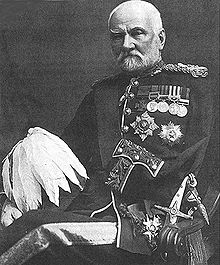Sam Browne belt

The Sam Browne belt is a wide belt, usually leather, which is supported by a strap going diagonally over the right shoulder. It is most often seen as part of a military or police uniform.
Origins


Sam Browne was a British army officer serving in India in the 19th century. In those days officers always carried a sword into battle. It hung from a little metal clip on the waistbelt, called a 'frog'. However, the scabbard tended to slide around a lot when they charged the enemy, meaning that it had to be steadied with the left hand before being drawn.
During the Indian Rebellion of 1857 in India, Captain Sam Browne was serving with the 2nd Punjab Irregular Cavalry. On 31 August 1858, Captain Browne was involved in the fighting near Seerporah. As he charged a cannon being reloaded, he was attacked by one of its crew. Browne received two sword cuts, one on the left knee and one which severed his left arm at the shoulder. He survived the injuries but without a left hand, he found that he was now unable to control or draw his sword.
Browne came up with the idea of wearing a second belt which went over his right shoulder and held the scabbard in just the spot he wanted. This would hook into a heavy leather belt with "D-rings" for attaching accessories. It also securely carried a pistol in a flap-holster on his right hip and included a binocular case with a neck-strap. Other cavalry officers in the Indian Army began wearing a similar rig and soon it became part of the standard uniform. During the Boer War, the rig was copied by Imperial and Commonwealth troops and eventually became standard issue.
Infantry officers wore a variant that used two suspender-like straps instead of the cross-belt. It was supposedly invented in 1878 by Lieutenant Sir Basil Templer Graham-Montgomery, 5th Baronet Stanhope of the 60th Rifles while serving in India. There has been a great deal of discussion as to whether Browne modified Graham-Montgomery's design or vice-versa. Since there were no patents issued for either design and both camps have accounts backing up their claims, it may never be decided.
Usage
Due to its former use as equipment for carrying a sword, it is traditionally only worn by those to whom a sword would historically have been issued, namely officers. Throughout most of its modern history, however, its main function has been to carry a pistol, and it was found to be particularly useful with the heavy pistols typically used during the first part of the 20th century.
United Kingdom
In the 20th century it was a mainstay in the British Army officers' corps, being adopted service-wide in 1900 during the Second Boer War after limited use in India, and later becoming popular with military forces throughout the Commonwealth. A different arrangement to the traditional Sam Browne belt was also popular with British and Commonwealth armed services; this consists of a similar wide belt with two vertical supporting straps, one over each shoulder, and its invention is also sometimes attributed to Browne, although other sources say he got the idea from a saddlemaker. After World War II the Sam Browne belt saw a decline in use in the Commonwealth; for example, it was phased out by the Canadian military with the unification of the armed services in 1968. However, officers, and Warrant Officers (WO1 & WO2) such as Regimental Sergeants Major and other Warrant Officers Class 1 & 2 of the British Army and Royal Marines still wear it in formal (No.2) dress and in some versions of full (No.1) dress.[citation needed] In Australia all officers are entitled to wear the belt in ceremonial dress, also Warrant Officers bearing the rank of WO1 (but not WO2) are entitled to wear the belt.
King Alfonso XIII of Spain wore his Sam Browne the wrong way round on his first inspection of the 16th The Queen's Lancers as Colonel-in-Chief in 1906. In advance to his arrival, someone noticed this error and informed the commanding officer, he then ordered all those wearing Sam Browne belts to reverse those as well. This tradition has gone on through until today, with The Queen's Royal Lancers wearing their stable belt and Sam Browne belt in reverse.[citation needed]
United States
During World War I, the Sam Browne Belt was approved by General Pershing, commander of the AEF, for wear by American officers as a rank distinction. However, the Army as a whole never approved its use, and even went so far as to station MPs at stateside docks to confiscate them from returning officers. It was a standard part of the U.S. Army uniform between World War I and World War II (1927 to 1940). It was eliminated in 1940 as a costly use of leather and was replaced by an unlined leather or cloth waistbelt that was sewn to the officer's jacket.
A black leather Sam Browne Belt was adopted by the Marine Corps, and is worn by sword-bearing commissioned officers in the Corps today. Drill Instructors wear the sword frog on their web belts as a sign of their office during Basic Training.
The "Sam Browne belt" worn today by American police usually lack the cross-strap and the attachments for them. The belt fastens in the same way with the bar of the buckle engaging a pair of hooks and the end of the belt retained by a post and keeper loop. They are also frequently fully lined, as opposed to the old style half-linings, to support equipment the length of the belt.
Worldwide policing
The Sam Browne belt also enjoyed some popularity with civilian police agencies worldwide. It was probably most widely worn in this context during the 1940s and 1950s. This use has gradually faded out due to field safety concerns, although it is still worn by the Royal Canadian Mounted Police for ceremonial uniform duties, the New Jersey State Police duty uniform, and some American state police forces in their full-dress formal uniforms, including the Arkansas State Police, Kansas Highway Patrol, Missouri State Highway Patrol, NYPD Highway Patrol's, NYPD Ceremonial and NYPD Auxiliary Ceremonial Units' dress uniform.
In Australia, a white Sam Browne belt is worn by the Victoria Police Mounted Unit, the New South Wales Police Force VIP Cyclists, Protocol Inspector and Protocol Sergeant, NSW Police College Protocol Senior Sergeant and Protocol Sergeant wear a black coloured leather basketweave Sam Browne belt and strap with silver coloured fittings. The same Sam Browne belt is also worn by the Australian Federal Police Ceremonial Mounted Cadre.
In Italy a black Sam Browne belt with red trims is still worn by Carabinieri Warrant Officers (always when in service) and Officers (only at time); a white Sam Browne belt is also worn by Italian Police enlisted personnel. Reflective Sam Browne belts are a popular safety device among cyclists for increasing their visibility at night, and a bright orange version is often worn by school crossing guards in junior safety patrols.
Usage in WWII

The Sam Browne belt featured prominently in many uniforms used by the Nazi Party in Germany, again in imitation of earlier European uniforms. Adolf Hitler and other leading Nazis, as well as members of the Sturmabteilung, are frequently seen in photographs wearing one.
Safety
The Sam Browne belt has been proposed as a solution to occupational safety and health concerns about injury due to the weight of equipment on police officers' belts.[1]
See also
References
- ^ Soldo, Sandra (2004). "Overloaded: How the New South Wales police accoutrement belt plagues its wearers". Police Journal Online. 85 (1).
{{cite journal}}: Unknown parameter|month=ignored (help)
